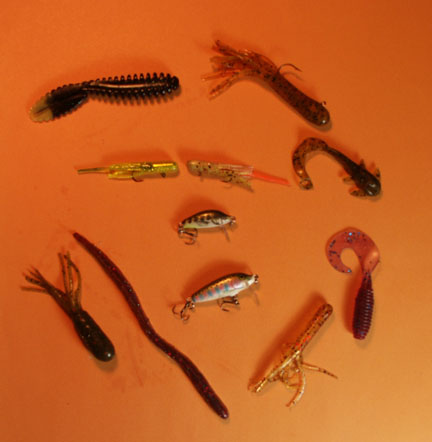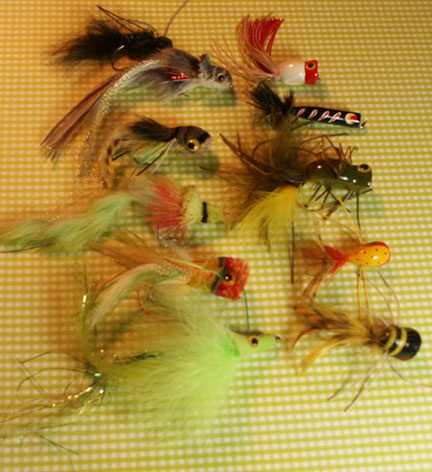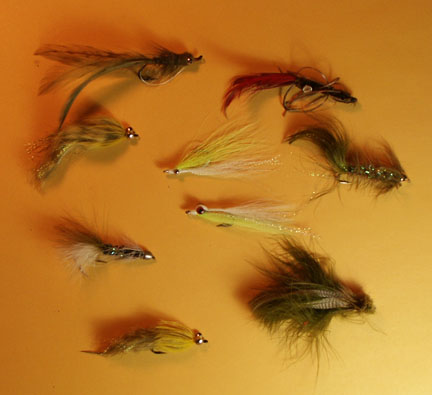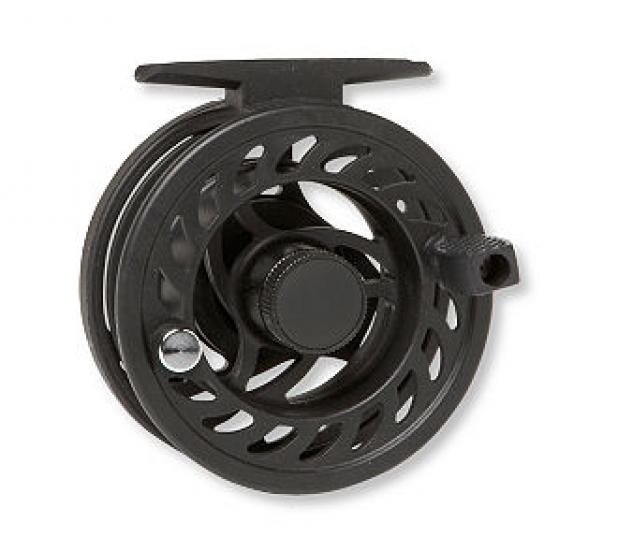To defy the rigid orthodoxy of contemporary fly fishing and eliminate fur, feather and hair from the artificial lure or "fly" brings to mind Hemingway's protagonist flipping live hoppers in his short story, Big, Two-Hearted River. My own father fished the Sierra-Nevada creeks and streams with a South Bend fly rod, but he never carried anything resembling a fly, preferring instead to head out to his favorite creek with live crickets, grasshoppers, grubs and, of course, worms. During the past decade many outdoor writers, searching for another writing angle to add to the plethora of expanding advice, have looked to the past. Guess what they have discovered? Many of our grandfathers and great-grandfathers thought of themselves as fishermen or anglers rather than rigidly identifying themselves as spin fishermen, bait casters or fly fishermen!

The outdoor writers churn out mind-numbing challenges for greater fishing prowess and finesse. In fairness, however, some writers are rediscovering that a plastic creature dangling at the end of a fly rod is not a mortal sin. My own creature of choice is a Berkley Power Bait Atomic Teaser or a small Gitzit (tube bait). My own journey of discovery began over thirty years ago when I watched a young man stick a good-sized largemouth using a ten-foot fly rod and a weighted deer hair abomination. He was flipping to dead treetops during a low water year on Lake Orville on the South Fork arm of the Feather River. During that same period of the early 70's, I caught small mouth bass with my fly rod and a Woolly Worm on the Russian River with a friend . My duck-hunting partner, Bill DeWalt, took me to a farm pond where we caught bass on poppers during the evening bite. I had great fun, but I looked at the sport with disdain, preferring instead to drive four and five hours into the Sierra Mountains for the supreme rainbow trout. What an idiot I was to ignore bass for more than thirty years. Equally stupid was to set aside my fly rod for two or three years as I learned conventional bass fishing with a bait casting rod. Now I never leave home without both conventional gear and fly-fishing gear. It doesn't get any easier than flipping out a Gitzit, a one-inch plastic-lipped minnow or a three-inch worm or grub at the end of a fly rod.
Plastic Creatures on the Bottom
Keep it simple. Take one of your old leaders that has been broken off to about three or four feet and about 1X or 2x in strength and attach a #1 Mosquito Hook or a #2 Gamakatsu hook. Better yet, tie on a three or four foot piece of 20-lb monofilament with any old hook that is available to you! Thread your plastic creature on the hook Texas rigged or with the hook exposed such as it is with an Atomic Teaser or a small jig. Use a dry fly line or a sinking tip line and fish the same structure as you would if you were fishing with conventional gear. Remember what you learned when reading Gary LaFontaine's book, Fly Fishing the Mountain Lakes? If you didn't read this excellent book on trout fishing, let me sum up his stillwater nymph fishing advise. Be still! Don't be impatient. Bottom crawling creatures barely move!
It is one thing to know this and quite another to practice it. A couple of years ago I was fishing with my son on Davis Lake, a fly fishing only lake below Bend, Oregon. Our strikes and fish landed were few and far between. I backed off the boat from the tulles and slowly stood up after I made a cast. I was using Denny Rickard's Sealbugger. As I watched it hit the surface, I could see smaller bass skedaddle and then tentatively reappear in the vicinity of the fly after about thirty or forty seconds. After about a minute or two, I watched as two larger fish slowly swam from cover to inspect the offering. They too never closed in on the fly, but instead they circled and headed back to their lairs. When I gently twitched the fly or crawled it one or two inches, the bigger fish would re-inspect the plastic creature. Sometimes I would repeat this procedure three or four times with long pauses in between before a fish would suck up the offering. Many times I would be spotted peering at them through my Polaroid sunglasses from a distance of thirty feet. No matter--I had learned my lesson and went on to catch upwards of 20 fish in the next couple of hours. Bass are explosive on the surface, but they are quite timid when bottom feeding, much like a brown trout on Montana's Rock Creek.
Tick! Tick! --Who's There?
Awh, the subtly and nuance of knowing when a fish has glided up to your offering, flared his gills and gently sucked in your lure only to spit it out as non-edible. One thing that you learn in bass fishing, regardless of gear, is to watch your line for any slight, telltale movement. Set the hook! Always keep your line straight and taunt. When I can't stand it any longer and I want to twitch or walk my creature a couple of inches, I first gently lift up on the rod and allow the plastic creature to settle back to the bottom where I wait again before moving it a couple of inches. I am always surprised when I feel resistance as I lift the rod tip up from its lowered position.
Surface Action

Lest anyone think that I have great success every time I go bass fishing, think again. I have plenty of days in the spring where I fish for hours, try every thing I have in my tackle box or vest and still go home skunked. In July and August fishing slows down during the heat of day. Really good fishermen tough it out and catch fish under these difficult periods relying on skills and techniques honed over the years. Many of us prefer the shade of the afternoon, an early dinner and the anticipation of top water action as the sun sets on the horizon. Unlike the action on the bottom, surface strikes are violent and swift. A rule of thumb for floating deer hair creatures, sliders, chuggers and poppers is to cast and not move the fly until the last ring of surface disturbance has disappeared. Most of the experts call for slight movements of the fly with l-o-n-g pauses, and I concur. I have read a number of sources that contend that bass prefer calm water conditions when fishing with poppers. I have not found that to be true when the water is rippling from a gentle breeze, much the same as fishing a stillwater lake in Montana.
Streamers and Minnows

Why would a bass ignore a perfectly healthy minnow imitation crossing its path? Perhaps the healthy minnow could escape, and the bass would have expended great energy for naught. Perhaps that fat old bass is lazy and just wants easy pickings. With that in mind, your streamer or lure (and I mean lure) should imitate a wounded or struggling minnow. We all know this, but sometimes we fail to focus on the crippled minnow and begin stripping in the fly or lure like it was in escape flight. Denny Rickards, the author of a number of books on stillwater trout fishing, extols the importance of the pause or stall in retrieving a fly. Many insects pause from over exertion. As they regress in the water column and slip downward, trout move in for the easy take. Crippled minnows or dying forage fish will often struggle valiantly, over exhaust themselves and pause to regain their strength. It is the pause that often triggers the strike. Strip! Strip! Strip - Pause. More and more I turn to a Clouser minnow fly, which is a pattern developed for small mouth bass by Bob Clouser. Universally acclaimed for a plethora of species, this simple streamer pattern rides with the hook up and offers two bulging lead eyes. The pattern may also be utilized as a jig. When a Clouser doesn't work, I tie on a one-inch Crankbait.
I am not trying to reach depths of 12 to 15 feet. I use a dry fly line to fish just under the surface, reaching a depth of two or three feet. Recently I fished the John Day River in eastern Oregon. Renown for its small mouth bass fishery, I arrived too early in the spring. The water was high and roiled. I had the most success that day casting a small crankbait back into the eddies and protected waters along the bank. Stripping in the line immediately pulls the crankbait to its designed depth. I always got the strike on the pause.
So there you have it. If you like dogma and you want to be a purist, stick to hair, fur and feathers when casting to bass. If you want to catch more bass, think plastic! Finally, on the question of whether to spray fish attractant on your plastic or traditional fly, a little dab will do ya just fine when no one else is around. Being too un-orthodox might have unintended consequences.
Dave Archer
www.fishingtips101
www.glaciertoyellowstone.com
www.guidetohighway395.com
Merwin: Inexpensive Fly Fishing Tackle



Copyright © www.mycheapnfljerseys.com Outdoor sports All Rights Reserved